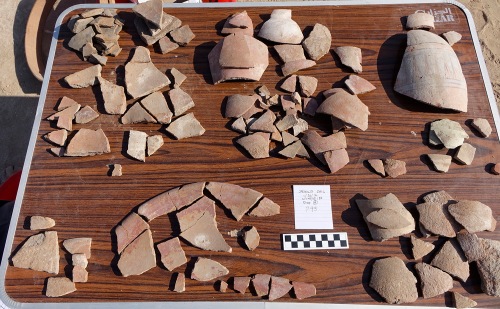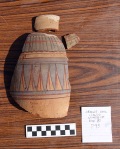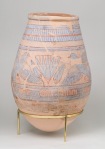https://imalqata.wordpress.com/2018/02/25/broken-dishes/
On 02/25/2018 07:07 AM, iMalqata Blog wrote:
Broken Dishes Susan Allen
While the pottery of the West Settlement has been buffeted by millennia of wind and water (from the wadi that runs through the site), much has been recovered from our recent excavations. This year, we were able to build on the progress made last year by Egyptian interns Aisha Mohamed Montaser and Hussein Fawzi Zaki, with the expert assistance of Pamela Rose. Using the corpus of pottery fabrics and forms developed by Pamela at Amarna, we are now tackling the substantial number of still-to-be-analyzed pottery groups.

A collection of sherds from the West Settlement
From each context (living surfaces, trash pits and other features) all pottery is collected and bagged. The first step is to lay out each group and divide the sherds into the two basic clay types: Nile silt and Marl clay (clay mined from desert sources). These are then divided between those from open forms (such as bowls), those from closed forms (jars, amphorae), and non-containers such as stands or lids. Each group is then sorted by surface treatment. Diagnostic sherds (rims, bases, handles, etc.) are counted and set aside for further analysis, comparison to the Amarna corpus, and in some cases for drawing. The body sherds, if they cannot be associated with a diagnostic form, are recorded and disposed of at a set location on site.
At this preliminary stage, it appears that the majority of the pottery is made of Nile silt and includes bowls and dishes of all sizes and medium-sized jars. Only a small percentage are Marl clay sherds, usually from large amphorae. Some of the bowls, especially the large ones, show indications of burning and were probably used as braziers, while smaller dishes were sometimes used as lamps. Each group collected usually includes a few pieces of the beautiful blue-painted decorated pottery that is characteristic of the late 18th Dynasty and particularly of the reigns of Amenhotep III and the Amarna period.


Left: Body and rim sherds from a blue-painted vessel found in the West Settlement. Right: Blue-painted vessel from The Met's earlier excavations at Malqata (Rogers Fund, 1911, 11.215.462)
The shapes and wares analyzed so far support the interpretation of this site as a settlement area, where non-elite inhabitants of the complex were living. The predominance of dishes, bowls and jars may show that they were used for the consumption of food prepared elsewhere at Malqata. The large Marl clay sherds mixed with a few imported types from elsewhere in the Levant come from wine and oil amphorae which would have been stored and consumed in areas like the Palace. These large sturdy sherds may then have been reused in the West Settlement as leveling and filling material.
-- Sent from my Linux system.
No comments:
Post a Comment